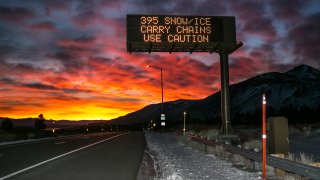
Snow and ice are expected to cover roads in Southern California's canyons and passes this week as a cold storm lashes the region.
Travel is highly discouraged with several feet of snow expected to accumulate by Saturday. A rare blizzard warning will be in effect Friday and Saturday for Los Angeles and Ventura county mountains.
Map: See where chain controls are in effect.
"Travel should be restricted to emergencies only,'' according to the National Weather Service. "If you must travel, have a winter survival kit with you. If you get stranded, stay with your vehicle.''
Get Southern California news, weather forecasts and entertainment stories to your inbox. Sign up for NBC LA newsletters.
When highway signs in those areas indicate chains are required, drivers must stop and install tire chains. Failing to do so can result in a citation and fine.
Below, some things to know from the Caltrans and the California Highway Patrol.
The Basics of Chain Requirements
- If you don't have chains, check your vehicle manufacturer's specifications.
- Control areas can change because weather and road conditions change. Be aware and watch for signs.
- When chains are required, the speed limit is 25 to 30 mph.
- Make sure you're completely off the road to the right when installing chains. Do not stop in a traffic lane.
- If using a chain installation service, get a receipt and the installer's badge number. Chain installers are not Caltrans employees.
- You'll see "End of Chain Control" signs when it's OK to remove chains. Drive beyond the signs, pull off the road and safely remove them.
Three Levels of California Chain Requirements
- Requirement 1: Chains are required on all vehicles except passenger vehicles and light-duty trucks under 6,000 pounds gross weight that are equipped with snow tires on at least two drive wheels. Chains must be carried by vehicles using snow tires. All vehicles towing trailers must have chains on one drive axle. Trailers with brakes must have chains on at least one axle.
- Requirement 2: Chains or traction devices are required on all vehicles except four- and all-wheel-drive vehicles with snow-tread tires on all four wheels. Four- and all-wheel-drive vehicles must carry traction devices in chain control areas.
- Requirement 3: Chains or traction devices are required on all vehicles, no exceptions.
Information: Call the Caltrans Highway Information Network at 800-427-7623 or check this map.

